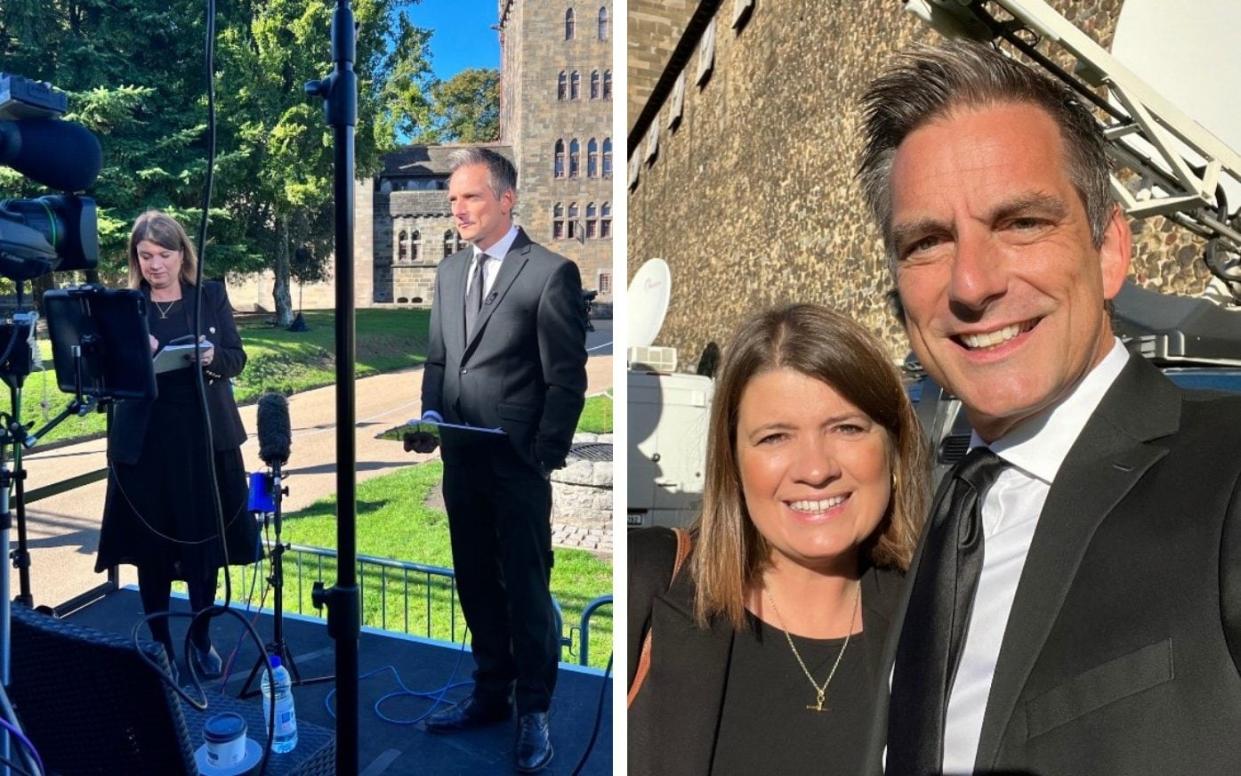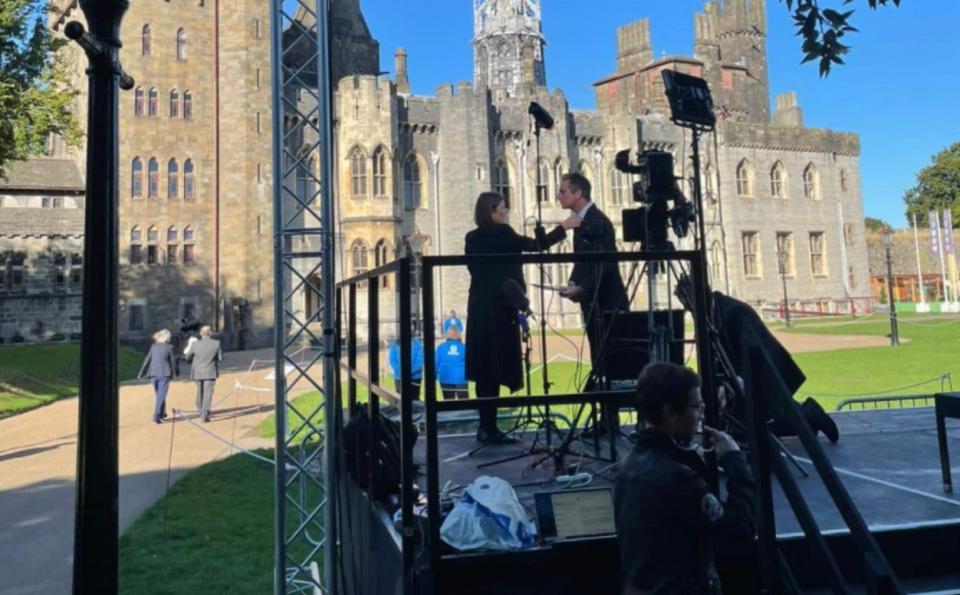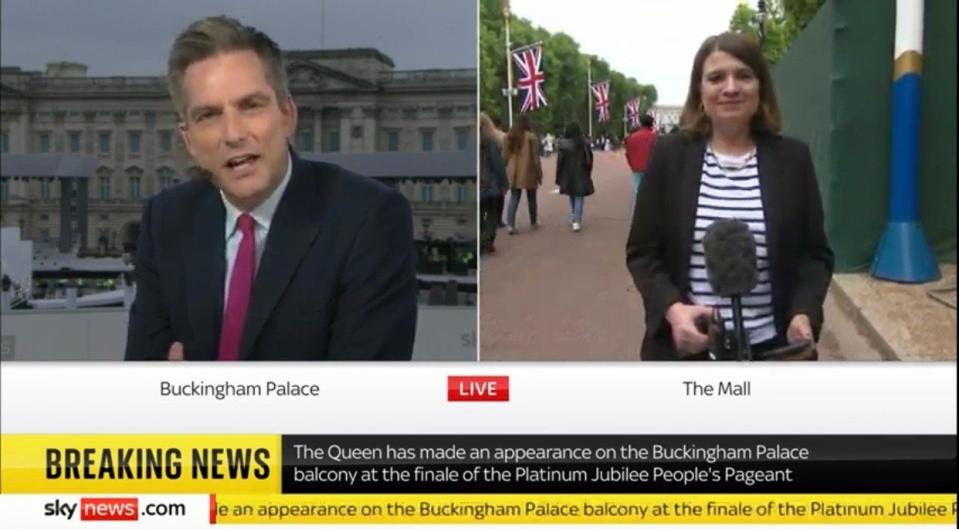What it’s like to report on Queen Elizabeth’s funeral as the ‘Richard and Judy of news’

“Darling, you’ve got food on your chin.”
As a Sky News presenter, I’m used to getting messages from colleagues in those adrenaline-fuelled moments before a live broadcast. But this wasn’t from just any colleague. It was from my wife, Laura Bundock, who had become one of the channel’s royal correspondents just three days before the death of Queen Elizabeth II.
We were under a crisp blue sky, in the magnificent grounds of Cardiff Castle, setting up for the arrival of the new King and Queen Consort, who were taking their first steps on Welsh soil since the sad announcement.
Notes have been prepared, scripts written, make-up applied and running orders assembled. The enormity of the story and the historical significance of what the nation was experiencing was not lost on me. Getting the tone spot on was paramount and I felt a huge sense of responsibility.
Laura and I were stood together on a small stage in front of the castle. As I wiped away the croissant crumbs, we straightened our shoulders and got ready to broadcast live. In between commentating over the grand service of reflection at Llandaff Cathedral and the King’s visit to the Welsh Parliament, Laura and I tried to manage our suddenly complicated domestic situation. “Tell your mum she can defrost some bolognese sauce for the kids’ tea,” I whispered to her as Charles’s motorcade swept into the Castle grounds. She scribbled on her notepad a message back: “Did you cancel Ned’s orthodontist appointment?”
It was turning out to be the most surreal fortnight.
For as long as I can remember, I have carried with me a now dog-eared dossier so I can be prepared for “Operation London Bridge”. This folder was full of royal facts and figures and details about the period of mourning and funeral. It has been with me everywhere, even on holiday.
And now, I was finally having to talk to the nation about this long-prepared-for event in the company of my wife.
Laura and I have worked together on and off for close to a quarter of a century, ever since our eyes first met over the newsroom computers in a BBC local radio station in Cambridgeshire.
At Sky, we are known as the “Richard and Judy of news” and our working and domestic lives are intertwined. During the pandemic, Laura would broadcast live from our spare room while I would plead with the kids and dogs to keep the noise down. Our kitchen has been the scene of numerous interviews and pieces to camera. I have even been known to borrow Laura’s compact when I’ve run out of TV make-up. We both always carry our passports with us and at least a couple of times a year one of us will phone the other from Heathrow saying “Er… I won’t be home tonight. I’m off to report on floods/earthquakes/EU summits.”
For our crews, it’s a source of endless amusement.

Most of the time with our strange shift patterns, we barely cross paths at work, although occasionally I will introduce Laura from the studio as she reports live from a location such as the Old Bailey, Westminster or a crime scene.
When we heard about the Queen’s death, Laura and I were actually in New York as a treat for my upcoming birthday. My parents were looking after the children, the dogs were sorted and this was a trip we had been looking forward to.
Less than 24 hours in and the news alerts started pinging on our phones. When the Queen’s death was announced, we looked at each other in silence, the gravity of the news sinking in. Sitting on the edge of the bed in our Manhattan hotel room, I started looking into flight options back to London, which were quickly disappearing as American TV networks booked seats.
We watched online as Sky’s other royal correspondent, Rhiannon Mills, who has years of experience in the job, was expertly guiding viewers through what had happened and what the plans would be for the period of mourning and funeral.
As journalists, one a brand new royal correspondent, we knew we had to get back for what would be one of the most important and significant stories of our lifetime.
We had lunch in a restaurant but ate little, checking our phones, fielding emails and feeling uneasy. We arrived back in the UK almost exactly 24 hours after we had left.
Once home, a courier dropped off some suitable black outfits for Laura to wear and within hours she was opposite Buckingham Palace, on air as a temporary studio was hastily built around her and our colleagues.
I explained to our children, aged 12 and nine, that we wouldn’t be around much for the next few days and roped in the in-laws who were happy to take over from my parents, drop everything and come and help. I emptied my suitcase of shorts and T-shirts suitable for New York sightseeing and threw in a dark suit and black tie. I’d been tasked with following King Charles around the country for a documentary as he visited Edinburgh, Belfast and Cardiff.
With both of us in jobs that are as far away as 9-5 as you can imagine, it is quite the juggle. We have had a succession of au pairs with varying degrees of success and regularly call in favours from a magnificent band of school parents. But both of us working for the same organisation is hugely helpful; we understand the pressures, the newsroom personalities and the unique demands of live, breaking news.

Over the period spanning the Queen’s death and funeral, Laura and I criss-crossed the country to the many regions where programmes were being filmed. Hurried texts between us asked: “Have you told your mum it’s cubs tonight?” Or (complete with thumbs up emoji): “I’ve managed to sort a lift for Martha’s hockey.”
At times, we did briefly meet up. In Belfast, we had a romantic dinner together (on a table squeezed between burly satellite engineers and cameramen).
In Cardiff, we saved Sky some money by sharing a hotel room. Past midnight, we were sat up in bed comparing notes and planning for the next day’s coverage. Then, as Laura was trying to drop off to sleep, I had to record some voiceover for my documentary. With the pillow over her head, a muffled voice complained: “Maybe we should have had separate rooms!”
Laura was being what’s known as a “presenter’s friend” – an expert who is on hand at all times to commentate and answer questions live on air, often having to fill the allotted air time with long periods of talking.
Normally, when I interview a presenter’s friend, I’ll maintain eye contact, smile and nod enthusiastically to encourage them to keep going. But what about when it’s your own wife? It is weirdly nerve-wracking interviewing the love of your life on TV. Knowing each other as well as we do, when our professional lives collide with our personal relationship, it is uncomfortable and awkward.
The solution we decided on was for me to ask the questions and when the camera had cut to her, I’d look away and busy myself with my notes so as not to put her off her stride. She was, of course, word perfect.
The day after the funeral, we wandered around our home in a daze, did the school run and walked the dogs. And we reflected on what the future of the monarchy will look like and more pressingly, what King Charles III will plan for his coronation. Questions you may spot me asking my wife, live on TV, in days to come.


